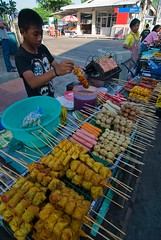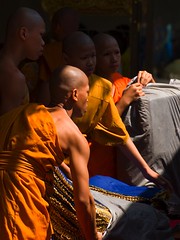We arrived yesterday, the 28th, from Trat once more into Bangkok. This is our fourth stopover in the capital as we travel across Thailand. This time we are here overnight and are about to leave in a couple of hours on a night bus to Chiang Mai. You usually do have to pass through Bangkok to travel to different parts of the country. We also had a couple of important jobs to do.
First was a regular antenatal check-up which we successfully had today at the Seventh Day Adventist Mission Hospital, a private hospital not far from the Democracy Monument. The high-class private hospital made the whole process incredibly easy with friendly, efficient English speaking staff.
Then I went off to buy a replacement Nikon lens for one I damaged earlier in Kanchanaburi. I spent most of the afternoon trying to find a basic 18-55 DX VR at a cheaper price than in the UK but it ended up costing about £40 more. Somewhat ironic given that Nikon lenses are actually made in Thailand!
Monday, 29 December 2008
Sunday, 28 December 2008
Snorkelling off the Elephant
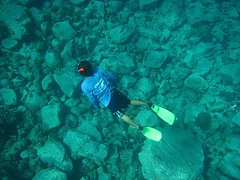
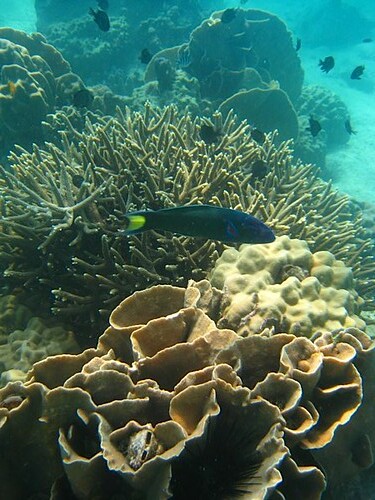
Koh Chang coral reefs
Our two and half weeks on Koh Chang and Koh Whai came to an end on the 27th December. There are many ways to fill up your time on these islands. Taking a walk along a beach, getting around to a breakfast of fresh fruit, rattling through a few chapters of a book. Everything you do seems to expand to fill the time available so that a small event can feel like a major accomplishment.
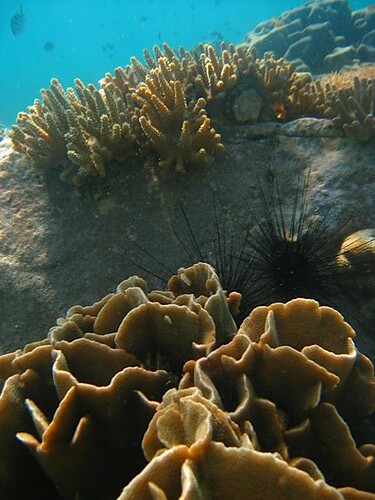
We spent a lot of time in the water and most of that was snorkelling. I probably did more snorkelling that just about all my previous snorkelling trips put together. This was largely because of being able to snorkel right off the beach. We both took at least one opportunity each day to take under water. I often swam three times a day for 1 to 2 hours, gauging how long i was out by how wrinkled my fingers became. We also took a fantastic trip with BB Divers, out of Bang Bao, to Koh Raum. The trip wa ostensibly a diving trip but three of us went along to snorkel. There was a guide available for us, but the water was so clear and calm, and the amazing reefs so close to the boat that we simply went off on our own.
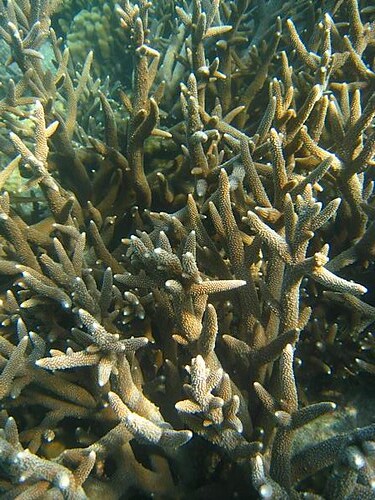
A forest of Staghorn Coral
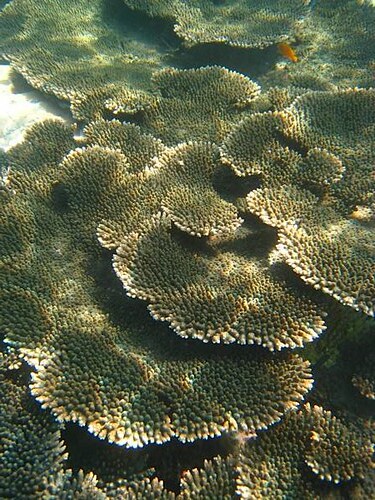
We have seen plenty of different types of coral and sea life between us. Hard corals include large expanses of staghorn corals, more pert chysanthymum and carnation formations, brain corals, flat plate-like corals and large coral mounds with undulating surfaces. We have also seen some rounded soft corals and individual crinoid-like corals waving their floral tentacles while secured by a hard coral tube. Sometimes brightly coloured Christmas Tree Worms and Clams can be found within the coral, having burrowed into the hard mounds below the coral's surface to find a home. Both filter feed on plankton floating by but have developed very different public faces to do so.
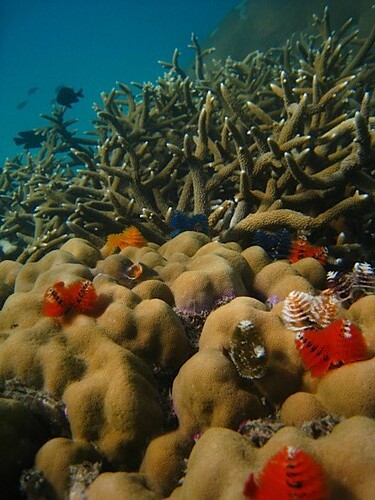
Christmas Tree Worms

Clams
I keep forgetting to look into a dark cracks between the rich display of coral colours, and it is in these gaps that some of the interesting sea life keep themselves hidden. We have seen an octopus, a moray eel and a baby sting ray betwee na dunder the corals. I also followed a pulsating rainbow cuttlefish across the sand and watched entranced by a small crayfish clearing out its burrow, throwing sand past its guardian fish on look out duty. I always enjoy spotting a chimney sponge reaching up from the deeper water.
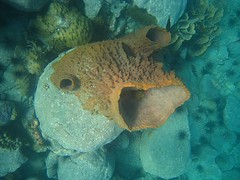
A Brown Chimney Sponge smiles for the camera
There have been many, many fish to swim with, far too many to know the names of. One of my favourites is the anenome fish which can resist the poison in the sea anenome's tentacles to use the anenome as a hiding place. It peeks from behind tentacles and tentatively swims out, while always keeping close to the anenome, with a nervous curiousity. It makes a clicking noise every time you bob close to it on the current.
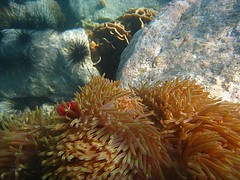
A pink anenome fish sneaks a peak from behind an anenome

Pink anenome fish getting curious in front of a sea anenome
We certainly recommend BB Divers to anyone interested in diving or snorkelling off Koh Chang. You can find out more info on their website - http://www.bbdivers.com - or by email - bbdivers@gmail.com. And where does the elephant come into snorkelling? Chang is Thai for elephant.
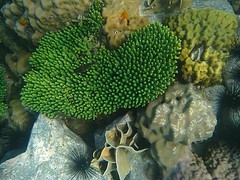
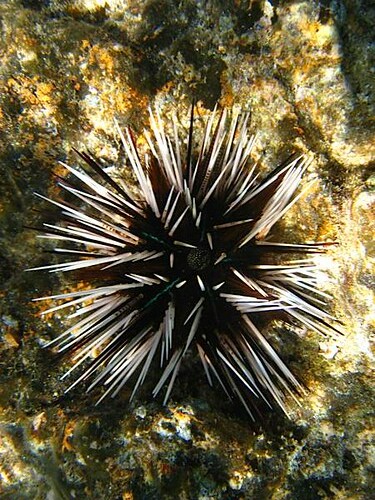
Thursday, 18 December 2008
Sugar Cane 2, Kanchanaburi
Sugar Cane is a pleasant mostly quiet place on the riverside about 10 minutes walk from the Bridge. I say mostly because the karaoke and party boats do ply the river from town to the bridge, passing the guesthouse. These are largely amusing diversions. However, we were in Kanchancaburi during the Bridge Week, which means many more boat-fulls of partying Thais and Farangs each night. There was also a lot of volume coming over from the fairground stage until about 1am. None of this really disturbed us though.
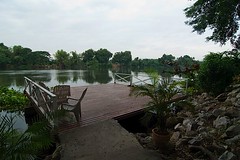
The guesthouse riverside platform. Great for morning yoga, afternoon sunsets and evening fireworks!
The little rooms with fan and bathroom were 200 baht a night and decent enough. The walls could have been cleaned, especially of the ancient splashes of toothpaste above the basin. The restaurant was good. The owner was very nice and four teenage girls, two organised and friendly, two pretty feckless, ran the place. A really nice guy was there for overnight security too. The girls even waved us off as we left.
Though the rooms are pretty small, and in that no smaller than most backpacker standard rooms or bungalows, they are en-suite which makes a difference for a longish visit. The guesthouse is arranged around a rectangular space which is part garden but mostly a gravel parking area. The Bamboo House, closer to the Bridge, has a much nicer and well-planned garden. The river-view restaurant produces good Thai food at reasonable prices and there is a metal platform over the river with a view of sunset and the Bridge. We saw the nearing of the moon, Venus and Jupiter from this platform in advance of the Sky Smile on the 1st December.

The guesthouse riverside platform. Great for morning yoga, afternoon sunsets and evening fireworks!
The little rooms with fan and bathroom were 200 baht a night and decent enough. The walls could have been cleaned, especially of the ancient splashes of toothpaste above the basin. The restaurant was good. The owner was very nice and four teenage girls, two organised and friendly, two pretty feckless, ran the place. A really nice guy was there for overnight security too. The girls even waved us off as we left.
Though the rooms are pretty small, and in that no smaller than most backpacker standard rooms or bungalows, they are en-suite which makes a difference for a longish visit. The guesthouse is arranged around a rectangular space which is part garden but mostly a gravel parking area. The Bamboo House, closer to the Bridge, has a much nicer and well-planned garden. The river-view restaurant produces good Thai food at reasonable prices and there is a metal platform over the river with a view of sunset and the Bridge. We saw the nearing of the moon, Venus and Jupiter from this platform in advance of the Sky Smile on the 1st December.
Tuesday, 9 December 2008
Kanchanaburi
We stayed at Kanchanaburi for two weeks, with a two-night visit to Erawan National Park in the middle. We have also published some thoughts on our Guest House, Sugar Cane 2.
We shouldn’t have even been at Kanchanaburi for this period because we had planned to be on Koh Whai for a few weeks after Ayutthaya. We even travelled to Trat, the nearest town to the pier for Koh Whai, but continual winds made the crossing uncertain. We travelled to the pier when we were told the boat was running only to find that strong winds were making the sea too rough for the speedboat. The forecast of a monsoon coming in from Vietnam encouraged us to head to Kanchanaburi early and let the weather calm down on the east coast. Given how much we did in Kanchanaburi and around in terms of cycling and hiking, this was certainly a good move as it would have been much harder for Georgia to be so active later in her pregnancy.
Kanchanaburi is in-effect four separate towns. There is the Thai town itself, typical in being built-up, polluted and noisy. This is where the bus station is found, along with a small night market, day market, the Allied War Cemetery and Thai Burma Railway Centre. The river beside the town forms a town in its own right, comprising restaurants, bars and the pier for the infamous karaoke boats. There is also the JEATH War Museum which is in the grounds of an interesting Buddhist temple. This area was the original backpacker locale a couple decades ago. Further towards the Bridge there is the current foreign tourist strip along a road running between the river and the main road. It is a combination of low-end and mid-range guest houses, mostly set on the river, with numerous roadside bars, restaurants, internet centres, Thai massage parlours, pharmacies, moped and bicycle rentals and bookshops, along with the ubiquitous 7-Eleven, lining the road. This is the place for 50 baht beers and the chance to meet other tourists. When we were there, most bars were sporting perhaps one to three foreigners, most of them sipping their beers in silence. This could be a sign of the worldwide economic downturn and preceded the airport blockade. Many of the tourists on view are male and heavy on skinheads, tattoos and younger female Thai partners. We guess that most of the large numbers of tourists we saw at the Bridge itself eat and drink in their guesthouses or hotels. The fourth town is where we stayed. This was a quieter area of bars and hotels on the same road as the main tourist strip. Everything is more spaced out, creating a semi-rural feel, and frequented by a mix of Thais and foreigners. Here are a series of large open-air bars where beers are more expensive at 100 baht a bottle, but for this you get beautiful wooded gardens, many lit by lanterns in the trees, that are set back from the road, some very tight live house bands, and waitresses on hand to keep your glass filled with that 100 baht beer whenever you’re in danger of reaching the bottom of your glass. Strangely the food on offer is little more expensive than that in the roadside bars further back towards the main town. One bar in particular, called the Resort, was where we found ourselves drinking when we went out at night. The double-priced beers were worth it given that I was usually only having one a night and Georgia wasn’t drinking at all. If you’re on for a few bottles you might prefer the economy of the tourist bars, but for that you have to put up with pollution and a less salubrious environment. We were happy to pay the extra, which would could a whole lot more in the UK for the equivalent level of quality. The Bridge is in easy walking distance from this area which is great because you get to pass some good food vendors on the street, including one of the main purveyors of quail’s egg wantons.
We shouldn’t have even been at Kanchanaburi for this period because we had planned to be on Koh Whai for a few weeks after Ayutthaya. We even travelled to Trat, the nearest town to the pier for Koh Whai, but continual winds made the crossing uncertain. We travelled to the pier when we were told the boat was running only to find that strong winds were making the sea too rough for the speedboat. The forecast of a monsoon coming in from Vietnam encouraged us to head to Kanchanaburi early and let the weather calm down on the east coast. Given how much we did in Kanchanaburi and around in terms of cycling and hiking, this was certainly a good move as it would have been much harder for Georgia to be so active later in her pregnancy.
Kanchanaburi is in-effect four separate towns. There is the Thai town itself, typical in being built-up, polluted and noisy. This is where the bus station is found, along with a small night market, day market, the Allied War Cemetery and Thai Burma Railway Centre. The river beside the town forms a town in its own right, comprising restaurants, bars and the pier for the infamous karaoke boats. There is also the JEATH War Museum which is in the grounds of an interesting Buddhist temple. This area was the original backpacker locale a couple decades ago. Further towards the Bridge there is the current foreign tourist strip along a road running between the river and the main road. It is a combination of low-end and mid-range guest houses, mostly set on the river, with numerous roadside bars, restaurants, internet centres, Thai massage parlours, pharmacies, moped and bicycle rentals and bookshops, along with the ubiquitous 7-Eleven, lining the road. This is the place for 50 baht beers and the chance to meet other tourists. When we were there, most bars were sporting perhaps one to three foreigners, most of them sipping their beers in silence. This could be a sign of the worldwide economic downturn and preceded the airport blockade. Many of the tourists on view are male and heavy on skinheads, tattoos and younger female Thai partners. We guess that most of the large numbers of tourists we saw at the Bridge itself eat and drink in their guesthouses or hotels. The fourth town is where we stayed. This was a quieter area of bars and hotels on the same road as the main tourist strip. Everything is more spaced out, creating a semi-rural feel, and frequented by a mix of Thais and foreigners. Here are a series of large open-air bars where beers are more expensive at 100 baht a bottle, but for this you get beautiful wooded gardens, many lit by lanterns in the trees, that are set back from the road, some very tight live house bands, and waitresses on hand to keep your glass filled with that 100 baht beer whenever you’re in danger of reaching the bottom of your glass. Strangely the food on offer is little more expensive than that in the roadside bars further back towards the main town. One bar in particular, called the Resort, was where we found ourselves drinking when we went out at night. The double-priced beers were worth it given that I was usually only having one a night and Georgia wasn’t drinking at all. If you’re on for a few bottles you might prefer the economy of the tourist bars, but for that you have to put up with pollution and a less salubrious environment. We were happy to pay the extra, which would could a whole lot more in the UK for the equivalent level of quality. The Bridge is in easy walking distance from this area which is great because you get to pass some good food vendors on the street, including one of the main purveyors of quail’s egg wantons.
Monday, 8 December 2008
Bangkok City-Break
The King and I
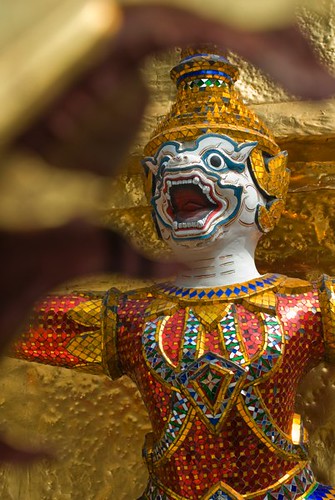
Demon of the Royal Palace
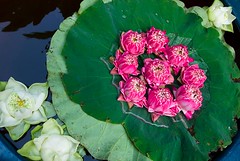
Lotuses in Jim Thompson's Garden
We are back in Bangkok for the weekend. We’re passing through on our way to Trat and the islands in the eastern Gulf of Thailand. An overnight stop makes the long journey from western to eastern Thailand bearable. Two nights and we have time to see a couple of our favourite places from our time in Bangkok in 2004. These are Jim Thompson’s House and the Grand Palace with Wat Phra Kaew.
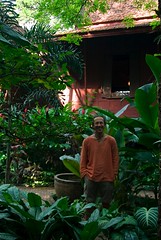
Standing in Jim Thompson's Garden behind his House
Jim Thompson was an international man of mystery. He came to Thailand to help liberate it from the Japanese at the end of WW2 but the war ended before he arrived so he worked in the region for the precursor of the CIA. On retirement he stayed in Bangkok where he helped to revive the silk industry and built a beautiful house out of five traditional Thai teak houses, furnished with Thai and Chinese antiques and surrounded it with a tame and cool jungle garden. This was 1959. Eight years later he went missing during a walk in Malaysia, never to be seen again. His house is an elegant legacy to Thai style and his own tastes.
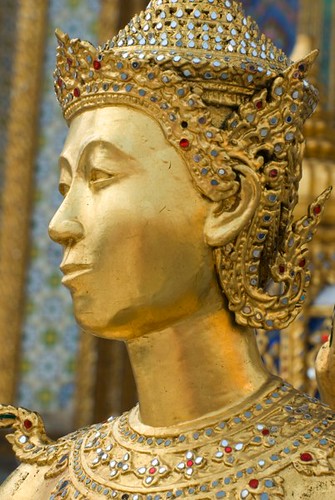
Golden statue in Wat Phra Kaew
The Grand Palace was the home of the Kings of Thailand until recently. This massive walled sanctuary in the centre of old Bangkok is now the major tourist attraction in town. The ridges of elegant traditional steeply pitched red-tiled Thai roofs break the skyline one after the other. They compete with technicolour prangs and golden chedis to dazzle with their gold and enamel splendour. There can be few places in the world with such sumptuous architecture that renders the art of the most beautiful handwoven silks into wood, stone and clay.
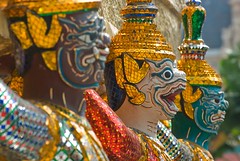
Wat Demons?
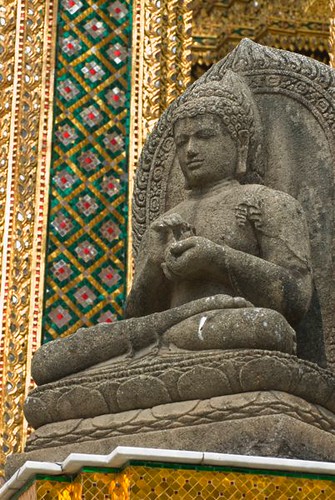
The jewelled highlight of the Palace is the Royal Temple – Wat Phra Kaew. Westminster Abbey falls into the Wats deep shadow by comparison, little more than a dusty parish church next to an eruption of rubies, sapphires, emeralds and gold. Multi-hued enamel-coated demons hold up towering prangs next to the three wats that are giant jewellery boxes turned inside out. The gorgeous serene faces of mythical creatures that are half-bird and half-woman stalk the terraces in between. The Emerald Buddha, a jade statue, sits high up on a golden mound of lotus buds and attracts Thai pilgrims to pray at its feet at the very spiritual heart of the Thai Kingdom.
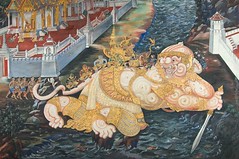
Ramakian Monkey
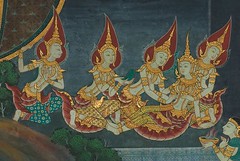
Sitting with Queen Sita
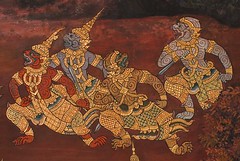
This exquisite world of make believe is enclosed within four walls on which the story of the Ramayama, known as the Ramakian in Thailand, is rendered in gold leaf pictures that together must form one of the largest figurative paintings in the world. The skill of the craftsmanship, the ornate detail, the epic scale of the story and sheer size re breathtaking. Stroll around the cool cloisters in front of this work and behold a tapestry of colour that makes the Bayeux Tapestry look like a well-stiched hankerchief. The dazzling art and architecture will hold you through the heat and beyond hunger to be refreshed and fed by splendour meant for the minds of kings.
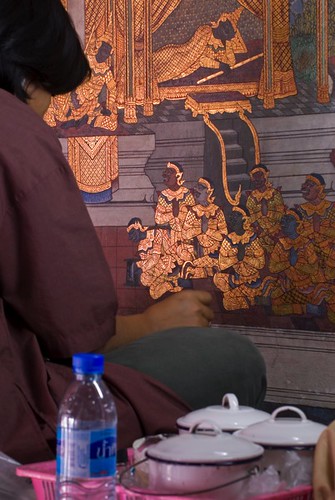
Restoring the Ramakian

Demon of the Royal Palace

Lotuses in Jim Thompson's Garden
We are back in Bangkok for the weekend. We’re passing through on our way to Trat and the islands in the eastern Gulf of Thailand. An overnight stop makes the long journey from western to eastern Thailand bearable. Two nights and we have time to see a couple of our favourite places from our time in Bangkok in 2004. These are Jim Thompson’s House and the Grand Palace with Wat Phra Kaew.

Standing in Jim Thompson's Garden behind his House
Jim Thompson was an international man of mystery. He came to Thailand to help liberate it from the Japanese at the end of WW2 but the war ended before he arrived so he worked in the region for the precursor of the CIA. On retirement he stayed in Bangkok where he helped to revive the silk industry and built a beautiful house out of five traditional Thai teak houses, furnished with Thai and Chinese antiques and surrounded it with a tame and cool jungle garden. This was 1959. Eight years later he went missing during a walk in Malaysia, never to be seen again. His house is an elegant legacy to Thai style and his own tastes.

Golden statue in Wat Phra Kaew
The Grand Palace was the home of the Kings of Thailand until recently. This massive walled sanctuary in the centre of old Bangkok is now the major tourist attraction in town. The ridges of elegant traditional steeply pitched red-tiled Thai roofs break the skyline one after the other. They compete with technicolour prangs and golden chedis to dazzle with their gold and enamel splendour. There can be few places in the world with such sumptuous architecture that renders the art of the most beautiful handwoven silks into wood, stone and clay.

Wat Demons?

The jewelled highlight of the Palace is the Royal Temple – Wat Phra Kaew. Westminster Abbey falls into the Wats deep shadow by comparison, little more than a dusty parish church next to an eruption of rubies, sapphires, emeralds and gold. Multi-hued enamel-coated demons hold up towering prangs next to the three wats that are giant jewellery boxes turned inside out. The gorgeous serene faces of mythical creatures that are half-bird and half-woman stalk the terraces in between. The Emerald Buddha, a jade statue, sits high up on a golden mound of lotus buds and attracts Thai pilgrims to pray at its feet at the very spiritual heart of the Thai Kingdom.

Ramakian Monkey

Sitting with Queen Sita

This exquisite world of make believe is enclosed within four walls on which the story of the Ramayama, known as the Ramakian in Thailand, is rendered in gold leaf pictures that together must form one of the largest figurative paintings in the world. The skill of the craftsmanship, the ornate detail, the epic scale of the story and sheer size re breathtaking. Stroll around the cool cloisters in front of this work and behold a tapestry of colour that makes the Bayeux Tapestry look like a well-stiched hankerchief. The dazzling art and architecture will hold you through the heat and beyond hunger to be refreshed and fed by splendour meant for the minds of kings.

Restoring the Ramakian
Labels:
Architecture,
Arts,
Bangkok,
Demon,
Grand Palace,
Photography,
Ramakian,
Ramayama,
Siam,
Thailand,
travel,
Wat Phra Kaew
Skewered to Eat
Wanting Quails’ Egg Wantons
My latest Thai food craze is Quials’ egg wantons. We first discovered them in Kanchanaburi on the many fried food street vendors stalls. Most of the time when walking down street lined with food vendors there is no point in us looking at them. Invariably everything is meat or fish. Skewer of five or six fat-coated pork balls are a ubiquitous Thai delicacy. As are squares of processed fish that on first glance looks temptingly like tofu. Delicious wanton parcels hide chicken and pork, again. Less attractive are slashed shiny hot dogs. All are served dipped in pots of various chilli sauces, some with fish and prawns, others light and dark red sweet chilli. Racks and rack of skewers shove food in your face of no use to the vegetarian because of the three commandments of Thai food – thou shall eat chicken, fish and pork.
The thing is, we would really love to be able to join in the Thai love for grazing skewered snacks with chilli sauce. Vegetable spring rolls are a rarity mostly confined to tourist ghettos and tempura is totally absent from the streets. The discovery that some of the yellow crispy rice batter of wantons concealed quails’ eggs was like waking up on Christmas Day to discover that amongst all those presents with other peoples’ names on were some for you after all. We could join in the party at last!
I have never had quails eggs in Britain. A bit too much of a costly luxury. But at 10 baht for a skewer of five, which works out at about 20 pence given the plummeting pound, it was time to discover and indulge, which did mean overlooking the living conditions of the quails. I'm usually very strict to only have free range organic eggs in the UK except when going out for the occasional fried breakfast.
And yes, I did want the hot chilli sauce please, despite being a farang. Darker and hotter the better.
My latest Thai food craze is Quials’ egg wantons. We first discovered them in Kanchanaburi on the many fried food street vendors stalls. Most of the time when walking down street lined with food vendors there is no point in us looking at them. Invariably everything is meat or fish. Skewer of five or six fat-coated pork balls are a ubiquitous Thai delicacy. As are squares of processed fish that on first glance looks temptingly like tofu. Delicious wanton parcels hide chicken and pork, again. Less attractive are slashed shiny hot dogs. All are served dipped in pots of various chilli sauces, some with fish and prawns, others light and dark red sweet chilli. Racks and rack of skewers shove food in your face of no use to the vegetarian because of the three commandments of Thai food – thou shall eat chicken, fish and pork.
The thing is, we would really love to be able to join in the Thai love for grazing skewered snacks with chilli sauce. Vegetable spring rolls are a rarity mostly confined to tourist ghettos and tempura is totally absent from the streets. The discovery that some of the yellow crispy rice batter of wantons concealed quails’ eggs was like waking up on Christmas Day to discover that amongst all those presents with other peoples’ names on were some for you after all. We could join in the party at last!
I have never had quails eggs in Britain. A bit too much of a costly luxury. But at 10 baht for a skewer of five, which works out at about 20 pence given the plummeting pound, it was time to discover and indulge, which did mean overlooking the living conditions of the quails. I'm usually very strict to only have free range organic eggs in the UK except when going out for the occasional fried breakfast.
And yes, I did want the hot chilli sauce please, despite being a farang. Darker and hotter the better.
Kayak Down the River Kwai
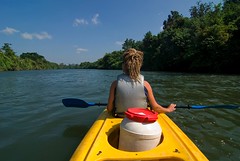
After enjoying our canoe journey down the River Macal in Belize last year, in fact juat about the same time last year, we decided to do the same down the Kwai. We hired a two-person kayak from Safarine, one of three tour companies offering kayak trips and rentals in Kanchanaburi. We mainly went with them because a, they were closest to our guest house and b, we had been recommended them by four lively retired Poles who we had met the first weekend in town when they reached shore at our guesthouse after a 400km journey down the River. The four men with huge appetites for alcohol, food and conversation after living on rations and with their own company for 12 days all live in Melbourne. We decided on something a bit more manageable. We were dropped off about 12km upstream at 11am and told to land the kayak at the Chinese Temple. The Safarine guide estimated it would take us about 3 hours.
The Kwai is not sluggish but we were paddling into a head wind which meant that at times we had to make something of an effort. Mostly, it was very plain going and was no where as strenuous as canoeing the shingle shallows and still deeps of the Macal. We passed between woodland, bamboo, fields as well as some very top-end luxury river resorts and architect-designed private houses. The River Kwai is clearly a play ground for the better off of Thai society.

A floating karaoke bar
After about two hours we were beginning to flag. We realised that out chances of finding a place to pull in and have lunch were diminished by most of the resorts being curiously closed. No sign of life emanated across manicured lawns or from tethered floating restaurants. Each place we passed was as quiet as a holiday resort in mindwinter, despite December being the start of the dry season and our trip taking place on a Friday which was the King’s Birthday and therefore a public holiday. Kanchanaburi had filled over the previous night with young Thais making the most of a long weekend. Upstream and upmarket was all empty hotels and proverbial tumbleweed.
We then spotted movement on one set of floating restaurants and made straight for it, hoping it was sign of life. Then we saw the sign – the Duneshine. This was Kanchanaburi’s longest established luxury resort, one we had passed the week before on bicycles and had been entertained by their brightly lit floating restaurants passing our guesthouse on weekend evenings. Our eyes lit up as we pulled the kayak on to the river bank, walked through the landscaped grounds and discovered their was restaurant was open. Glass noodle salad and noodles wrapped in an omelette refreshed us for what we knew now to be the last few kilometres back to Kanchanaburi.
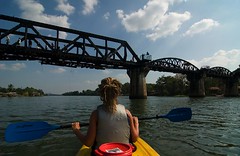

We passed below the Bridge Over the River Kwai within the hour, drifted past our guesthouse like the many karaoke boats had done every night and spotted the distinctive pagoda of the Chines Temple above the trees. Our micro adventurette was over, during which we had treat ourselves to a good lunch at a luxury hotel.
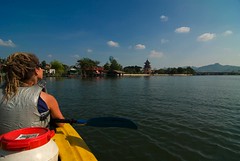
Chinese Temple to starboard bow
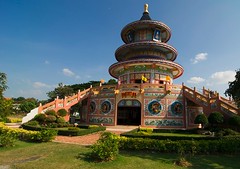
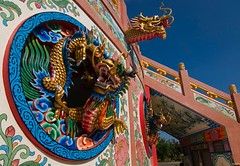
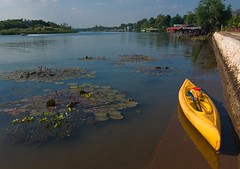
Labels:
Bridge Over the River Kwai,
Kanchanaburi,
kayak,
River Kwai,
Thailand,
travel
Saturday, 6 December 2008
Death Railway
Through the Thai mountains across the Bridge of Sighs.
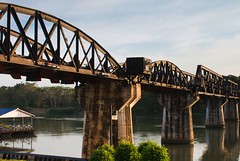
Bridge Over the River Kwai
One of the biggest draws for visitors to Kanchanaburi is the Bridge Over the River Kwai. This World War 2 railway bridge, built in Thailand by tens of thousands of Asian workers and Allied POWs under Japanese control, has become symbolic of the cruel treatment of prisoners in the 1940s. Thousands died during the railway’s construction. It is the British war film starring Alec Guinness, which has perhaps transported the bridge to this height. The film is an icon of the British stiff-upper-lip and courage in the face of appalling odds. Bizarrely a Frenchman wrote the novel that the film is based on.
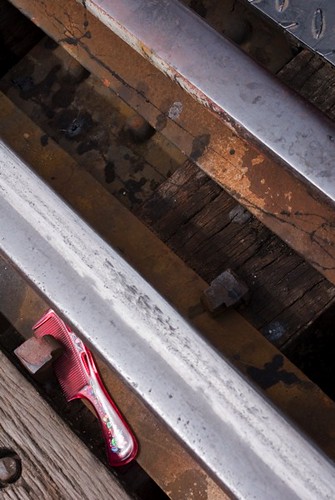
The bridge is a somewhat small piece of engineering to carry such a heavy historical load. The building of the Death Railway, or Thailand-Burma Railway, as it is known is encapsulated in seven iron girder spans, each a little taller than head height. It lives up to the weighty expectations placed on its sturdy concrete pillars, ensuring that the history is not forgotten while those with memories of the events fade away.
The Bridge is just one small part of the railway that runs through more than 400km of hazardous mountain jungle. According to contemporary accounts it was a relatively easy part of the construction project. Easy here is certainly relative. The easy part compares to most people’s idea of immense suffering with the ever-present threat of beatings, diseases, malnutrition and death. The rest of the railway line got harder the further into the mountains it went. Today, you can still travel as far as Nam Tok, about 60km into the hills, and in doing so cross original wooden trestles holding the line onto the side of a vertical cliff above the river. This is the main photo opportunity for tourists riding the line.
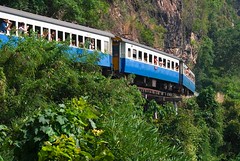
Wooden trestles still survive to hold the railway line on to the side of a cliff above the River Kwai
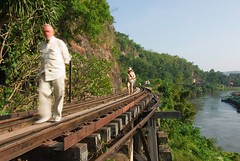
The Railway was built by the Imperial Japanese Army to create a land route from Thailand to Burma, the two countries being separated by a high mountain range. The sea route around the Malay Peninsula was prone to attacks by Allied battleships. They knew it would be a difficult feat of engineering because of the inaccessible terrain. This prohibited the use of heavy machinery resulting in the line being built totally by hand – picks, shovels and dynamite. All materials were carried in by foot and mule until the track began to be laid at the working railhead could be reached via the track.
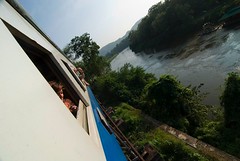
Riding the Line
While the Bridge is the main ‘attraction’, you can’t move far in Kanchanaburi without coming across evidence and memories of the suffering endured by slave workers on the Death Railway. As well as the bridge and railway line, there are two large Allied War Cemeteries, the excellent interpretation of the Thailand-Burma Railway Centre, the JEATH War Museum which was commissioned by the Abbot of the Buddhist monastery in which it stands and features reconstructions of bamboo prison huts hosting a photographic exhibition, and a memorial erected to the dead by the Japanese in 1944.
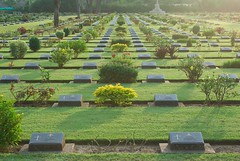
Chungkai Allied War Cemetery
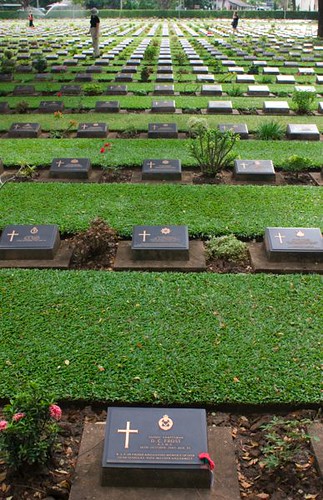
Kanchanaburi Allied War Cemetery
Estimates put the total number of deaths of slave workforce at about 100,00, most of who were Asian workers lured to the line by lies of paid jobs, and about 16,000 allied POWs. The all-powerful advancing Japanese Army had captured most of the POWs during their rapid onslaught in Singapore, Malaysia and Indonesia. By far the most POWs came from Britain, taken prisoner soon after arriving in Singapore when it inevitably fell to the Japanese. Large numbers of Dutch were captured in Indonesia. The deaths of so many of these captives building the railway have become one of the most enduring stories of World War 2.
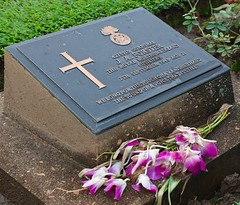
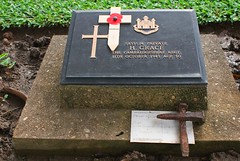
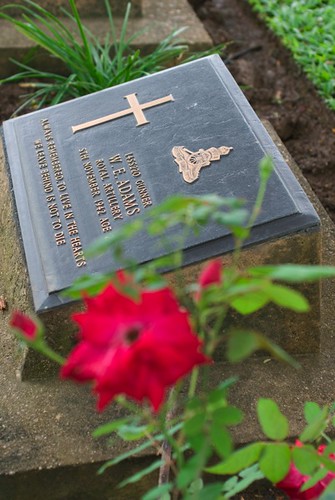
Some of the most touching moments of visiting places associated with the railway include seeing the blank eyes of POWs stare out from black and white photos, their shrunken bodies displaying ribs. Walking around the cemeteries you are struck by the ages of the men who died, so many in their early 20s, and the way that deaths cluster on certain runs of days, presumably when conditions or work rate became extremely terrible. One story that lodges in the heart is of the man who’s father survived years of captivity to return home, conceive two children then die of aggressive hypertension. The bravery of doctors who treat sick men with primitive equipment made from borrowed and improvised materials and almost no drugs comes to the fore again and again.
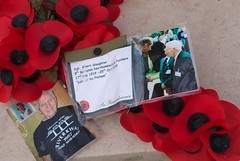
These stories of brutality, suffering and of the personal strength of those who tried to live through are mere glimpses into a past of unimaginable terror and courage. They still draw thousands of relatives of these men to Thailand every year, while the number of survivors themselves dwindles.
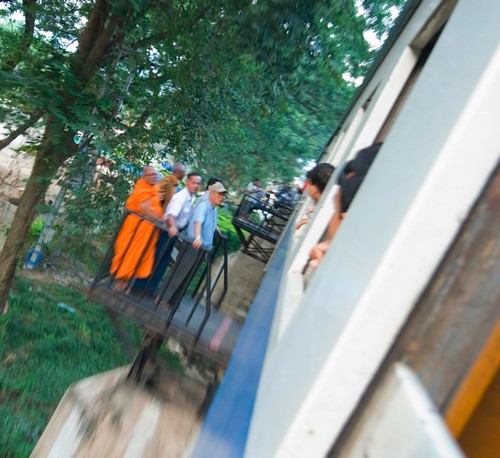

Bridge Over the River Kwai
One of the biggest draws for visitors to Kanchanaburi is the Bridge Over the River Kwai. This World War 2 railway bridge, built in Thailand by tens of thousands of Asian workers and Allied POWs under Japanese control, has become symbolic of the cruel treatment of prisoners in the 1940s. Thousands died during the railway’s construction. It is the British war film starring Alec Guinness, which has perhaps transported the bridge to this height. The film is an icon of the British stiff-upper-lip and courage in the face of appalling odds. Bizarrely a Frenchman wrote the novel that the film is based on.

The bridge is a somewhat small piece of engineering to carry such a heavy historical load. The building of the Death Railway, or Thailand-Burma Railway, as it is known is encapsulated in seven iron girder spans, each a little taller than head height. It lives up to the weighty expectations placed on its sturdy concrete pillars, ensuring that the history is not forgotten while those with memories of the events fade away.
The Bridge is just one small part of the railway that runs through more than 400km of hazardous mountain jungle. According to contemporary accounts it was a relatively easy part of the construction project. Easy here is certainly relative. The easy part compares to most people’s idea of immense suffering with the ever-present threat of beatings, diseases, malnutrition and death. The rest of the railway line got harder the further into the mountains it went. Today, you can still travel as far as Nam Tok, about 60km into the hills, and in doing so cross original wooden trestles holding the line onto the side of a vertical cliff above the river. This is the main photo opportunity for tourists riding the line.

Wooden trestles still survive to hold the railway line on to the side of a cliff above the River Kwai

The Railway was built by the Imperial Japanese Army to create a land route from Thailand to Burma, the two countries being separated by a high mountain range. The sea route around the Malay Peninsula was prone to attacks by Allied battleships. They knew it would be a difficult feat of engineering because of the inaccessible terrain. This prohibited the use of heavy machinery resulting in the line being built totally by hand – picks, shovels and dynamite. All materials were carried in by foot and mule until the track began to be laid at the working railhead could be reached via the track.

Riding the Line
While the Bridge is the main ‘attraction’, you can’t move far in Kanchanaburi without coming across evidence and memories of the suffering endured by slave workers on the Death Railway. As well as the bridge and railway line, there are two large Allied War Cemeteries, the excellent interpretation of the Thailand-Burma Railway Centre, the JEATH War Museum which was commissioned by the Abbot of the Buddhist monastery in which it stands and features reconstructions of bamboo prison huts hosting a photographic exhibition, and a memorial erected to the dead by the Japanese in 1944.

Chungkai Allied War Cemetery

Kanchanaburi Allied War Cemetery
Estimates put the total number of deaths of slave workforce at about 100,00, most of who were Asian workers lured to the line by lies of paid jobs, and about 16,000 allied POWs. The all-powerful advancing Japanese Army had captured most of the POWs during their rapid onslaught in Singapore, Malaysia and Indonesia. By far the most POWs came from Britain, taken prisoner soon after arriving in Singapore when it inevitably fell to the Japanese. Large numbers of Dutch were captured in Indonesia. The deaths of so many of these captives building the railway have become one of the most enduring stories of World War 2.



Some of the most touching moments of visiting places associated with the railway include seeing the blank eyes of POWs stare out from black and white photos, their shrunken bodies displaying ribs. Walking around the cemeteries you are struck by the ages of the men who died, so many in their early 20s, and the way that deaths cluster on certain runs of days, presumably when conditions or work rate became extremely terrible. One story that lodges in the heart is of the man who’s father survived years of captivity to return home, conceive two children then die of aggressive hypertension. The bravery of doctors who treat sick men with primitive equipment made from borrowed and improvised materials and almost no drugs comes to the fore again and again.

These stories of brutality, suffering and of the personal strength of those who tried to live through are mere glimpses into a past of unimaginable terror and courage. They still draw thousands of relatives of these men to Thailand every year, while the number of survivors themselves dwindles.

Labels:
Allies,
Bridge,
Death Railway,
Kwai,
Photography,
Prisoners of War,
Railway,
Thailand,
travel,
World War 2
Thursday, 4 December 2008
Monk Light
One of a number of monks packing up tables laid with food at Wat Panang Choeng, Ayutthaya, Thailand. The meal was put on for hundreds of visitors during Loi Krathong in November 2008.
Erawan Waterfalls
Bathing with the Doctor Fish of the Elephant Falls
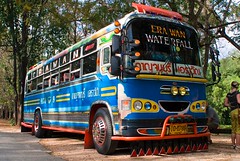
The bus back from Erawan had the destinations pretty clearly spelled out on the windscreen.
We saw the blunt front end of the bus slowly making its away along the road, pick-up trucks and mopeds weaving around it. Luckily the driver also saw us, standing by the side of the road, opposite a pet food store that had done a roaring trade from passing moped riders in the 20 minutes we had waited, and pulled over. Georgia shouted ‘Erawan?’ over the clunking chug of the ancient engine, to which the driver nodded. Had he really heard as pistons thumped and the whole bus rattled? A quick double-check on our way up the steps confirmed we had and we were on our way for a two-night camping stay at Erawan National Park, home of a nationally famous seven-tiered waterfall.
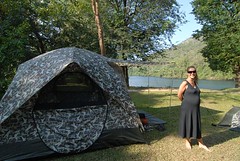
River View Camping
A bone-shaking hour later and we were at the campsite, completing our camping hire form. A 150 baht 3 person tent rather than the smaller 90 baht 2 person version. Sleeping bags, pillows and what we would discover was optimistically called a lantern. Thai National Park tents are both excellent quality and enjoyable designed, being covered in a muted psychedelic abstract pattern of repeating trees, trunks and white birds. Our tent, kindly upgraded to a palatial 220 baht model for no extra cost, had a view of the River Kwai Yai, which also meant we could hear every vehicle along the road opposite.
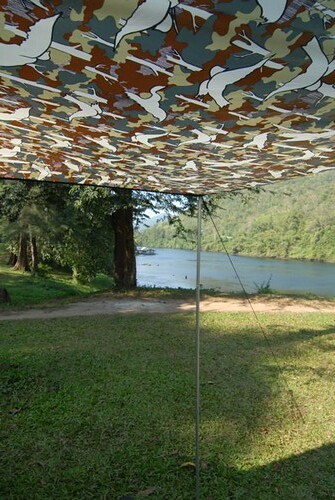
The waterfalls are worth more than the couple of hours romp that most tour companies give their groups. The clear cool blue water pours over a ridge to cascade over a series of limestone steps until it reaches flat ground 1.5km downstream. Most of the pools are created by the waterfalls themselves by depositing calcium carbonate in shelves, mounds and ridges in much the same way as limestone water furs up a kettle. Except in Erawan the process creates a series of amazing bathing pools, each with its own Jacuzzi and water massage system. Each of the seven tiers is extremely different in character depending on the nature of the waterfall and the pool created. What every tier shares is the experience of a jungle paradise with lush rainforest trees, creepers and palms crowding all around to create a vibrant green frames to cool blue pictures. David Hockney would surely be inspired to develop a Rousseauesque phase.
You can easily reach Erawan by bus from Kanchanaburi bus station. The one and a half hour journey takes you right to the Park HQ for 50 baht. There is also a 200 baht entry fee. It is easy to do it in a day as long as you remember the last bus back leaves Erawan at 4.00pm. Otherwise there are bungalows and, of course, the range of tents to hire at the HQ. By camping, we were given ourselves two and a half days to explore the falls and their surrounding jungle. It was a bit like having a festival with seven stages and numerous art trails. Each fall even had its own sound, a variation on rushing water set to different rhythms and pitches.
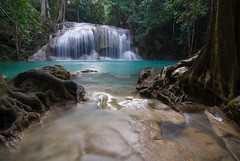
Erawan Two
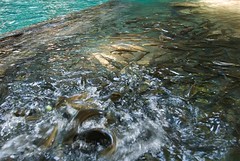
Feeding frenzy with Doctor Fish
Levels one and two are both large bulbous falls that rush over wide, steep drops into series of swimming pools that continue downstream in wide steps. These are the family playgrounds, surrounded by bamboo platforms, toilets and food. Here, though, are the most vociferous of the ‘Doctor Fish’, a sort of trout-cum-catfish that nibbles your toes, feet, legs, in fact any part of your body while in the water for dry skin. The feeling can be a ticklish massage or a slithery hell depending on how you feel. Swimmers at level two have to brave the largest shoal of the biggest fish to get into the pool. Once swimming you’re completely safe from their raspy teeth but when you want to get out again…then it’s once more time to run the scaly gauntlet.
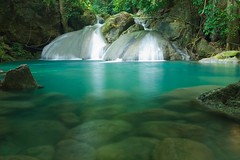
Erawan Four
Waterfall three is an impressive tall torrent hidden behind a bluff and difficult to get a clear view of how impressive the drop is or to slip into the pool for a swim. Quickly on to waterfall four, a large inviting pool backed by two large limestone mounds that the water seems almost to float over. A good clearing in the jungle creates a bright patch of sun-warmed water in the centre of the pool.
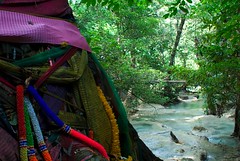
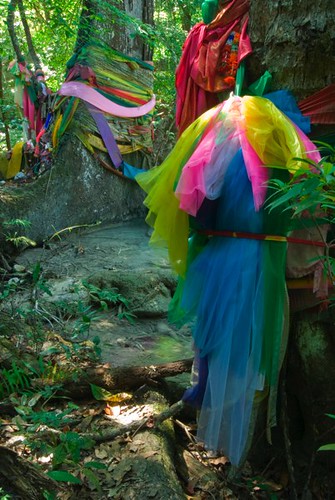
Water Spirit Houses
The longest trek is from four to five. It takes nearly 500m of scrambling uphill and climbing steep, rickety wooden steps, passing trees wrapped in brightly coloured cloths representing spirits houses. With Georgia being 5 and a half months pregnant we had to take it slowly. It wasn’t going to stop her however, and did enlisit one aside of ‘good girl’ from a passing tourist.
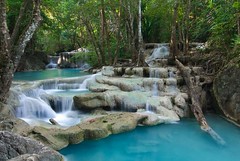
Erawan Five
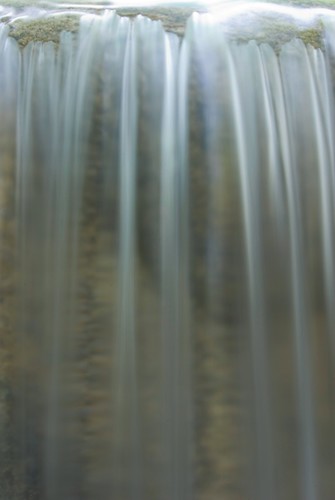
And waterfall five was worth the effort. For those who have visited Pamukkele in Turkey you will have a good picture of what waterfall five looks like. Here the falls are a series of broad, level cataracts formed of beds of calcium carbonate. The water falls and bubbles from one level to another over vertical edges reminiscent of their underground cousins – stalactites. This creates a natural spa of aquamarine pools of the clearest water, limestone steps connecting one to the other, and hydrotherapeutic massaging waterfalls complete with limestone benches to sit on. It seems that Paradise really does keep getting better the more steps you take.
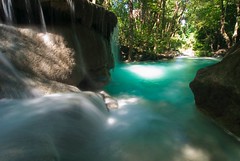
Erawan Five Downstream
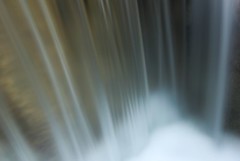
Which brings us on to waterfall six, as tall and hidden away a gem as three, kept secret by vines and trees, and to the finale – waterfall seven. This is the one that all the tour groups head towards. Waves of Russians, French, Britons, Thais and Americans, amongst many others, take off their trekking kit to reveal a wide range of skimpy, clinging, baggy or demure (depending on nationality) bathing gear and with trepidation walk, shuffle or leap into the pool. The air is filled with shrieks, not from cold water because the temperature of all the pools is pleasantly refreshing after the hike. The Doctor Fish, waiting at the edge of the pool for tourist toes to tickle and nibble, are the cause of the shouts. For most visitors this is their first experience of the slithering fish come to feed on their dead skin cells. It is enough to put many tourists off from taking the plunge. Other visitors keep still in disgusted pleasure, photographing the brown shoals fighting over scraps between their toes.
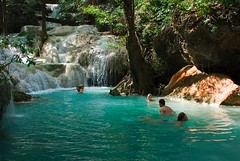
Erawan Seven with Georgia
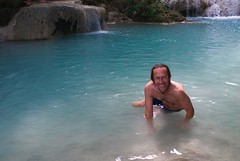
Like a James Bond film on a very bad day
The background to the pool is a steep series of limestone steps receding into the forest. Water cascades down them at a pace, forming a riot of many mini-falls that pound down from one to another. I scrambled up these, crossing a ‘ravine’ by a fallen tree, part of which was being ‘fossilised’ with calcium carbonate, pushing through branches and bracing myself against the force of the water. I felt almost adventurous enough to feel I could hold my own in a brief conversation with Ray Mears. Eventually the steps became too steep, the water too powerful to climb any higher. So I returned for a good swim in the pool below before descending all the way back to the very bottom via a swim and a fishy nibble in every other pool on the way. Except that I opted out of the feeding frenzy that awaited at waterfall two and instead enjoyed the recently arrived shrieking Russians discovering for themselves the Attack of the Thai Doctor Fish.
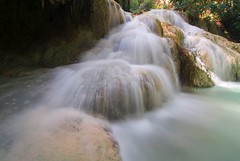
Erawan Seven as far as I went
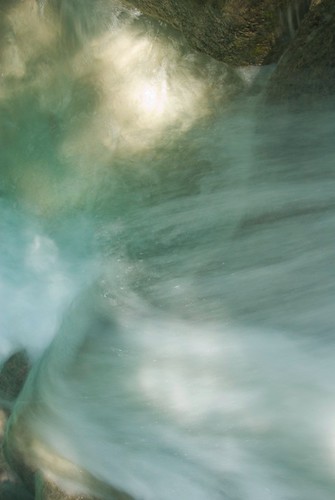
Water Lights

The bus back from Erawan had the destinations pretty clearly spelled out on the windscreen.
We saw the blunt front end of the bus slowly making its away along the road, pick-up trucks and mopeds weaving around it. Luckily the driver also saw us, standing by the side of the road, opposite a pet food store that had done a roaring trade from passing moped riders in the 20 minutes we had waited, and pulled over. Georgia shouted ‘Erawan?’ over the clunking chug of the ancient engine, to which the driver nodded. Had he really heard as pistons thumped and the whole bus rattled? A quick double-check on our way up the steps confirmed we had and we were on our way for a two-night camping stay at Erawan National Park, home of a nationally famous seven-tiered waterfall.

River View Camping
A bone-shaking hour later and we were at the campsite, completing our camping hire form. A 150 baht 3 person tent rather than the smaller 90 baht 2 person version. Sleeping bags, pillows and what we would discover was optimistically called a lantern. Thai National Park tents are both excellent quality and enjoyable designed, being covered in a muted psychedelic abstract pattern of repeating trees, trunks and white birds. Our tent, kindly upgraded to a palatial 220 baht model for no extra cost, had a view of the River Kwai Yai, which also meant we could hear every vehicle along the road opposite.

The waterfalls are worth more than the couple of hours romp that most tour companies give their groups. The clear cool blue water pours over a ridge to cascade over a series of limestone steps until it reaches flat ground 1.5km downstream. Most of the pools are created by the waterfalls themselves by depositing calcium carbonate in shelves, mounds and ridges in much the same way as limestone water furs up a kettle. Except in Erawan the process creates a series of amazing bathing pools, each with its own Jacuzzi and water massage system. Each of the seven tiers is extremely different in character depending on the nature of the waterfall and the pool created. What every tier shares is the experience of a jungle paradise with lush rainforest trees, creepers and palms crowding all around to create a vibrant green frames to cool blue pictures. David Hockney would surely be inspired to develop a Rousseauesque phase.
You can easily reach Erawan by bus from Kanchanaburi bus station. The one and a half hour journey takes you right to the Park HQ for 50 baht. There is also a 200 baht entry fee. It is easy to do it in a day as long as you remember the last bus back leaves Erawan at 4.00pm. Otherwise there are bungalows and, of course, the range of tents to hire at the HQ. By camping, we were given ourselves two and a half days to explore the falls and their surrounding jungle. It was a bit like having a festival with seven stages and numerous art trails. Each fall even had its own sound, a variation on rushing water set to different rhythms and pitches.

Erawan Two

Feeding frenzy with Doctor Fish
Levels one and two are both large bulbous falls that rush over wide, steep drops into series of swimming pools that continue downstream in wide steps. These are the family playgrounds, surrounded by bamboo platforms, toilets and food. Here, though, are the most vociferous of the ‘Doctor Fish’, a sort of trout-cum-catfish that nibbles your toes, feet, legs, in fact any part of your body while in the water for dry skin. The feeling can be a ticklish massage or a slithery hell depending on how you feel. Swimmers at level two have to brave the largest shoal of the biggest fish to get into the pool. Once swimming you’re completely safe from their raspy teeth but when you want to get out again…then it’s once more time to run the scaly gauntlet.

Erawan Four
Waterfall three is an impressive tall torrent hidden behind a bluff and difficult to get a clear view of how impressive the drop is or to slip into the pool for a swim. Quickly on to waterfall four, a large inviting pool backed by two large limestone mounds that the water seems almost to float over. A good clearing in the jungle creates a bright patch of sun-warmed water in the centre of the pool.


Water Spirit Houses
The longest trek is from four to five. It takes nearly 500m of scrambling uphill and climbing steep, rickety wooden steps, passing trees wrapped in brightly coloured cloths representing spirits houses. With Georgia being 5 and a half months pregnant we had to take it slowly. It wasn’t going to stop her however, and did enlisit one aside of ‘good girl’ from a passing tourist.

Erawan Five

And waterfall five was worth the effort. For those who have visited Pamukkele in Turkey you will have a good picture of what waterfall five looks like. Here the falls are a series of broad, level cataracts formed of beds of calcium carbonate. The water falls and bubbles from one level to another over vertical edges reminiscent of their underground cousins – stalactites. This creates a natural spa of aquamarine pools of the clearest water, limestone steps connecting one to the other, and hydrotherapeutic massaging waterfalls complete with limestone benches to sit on. It seems that Paradise really does keep getting better the more steps you take.

Erawan Five Downstream

Which brings us on to waterfall six, as tall and hidden away a gem as three, kept secret by vines and trees, and to the finale – waterfall seven. This is the one that all the tour groups head towards. Waves of Russians, French, Britons, Thais and Americans, amongst many others, take off their trekking kit to reveal a wide range of skimpy, clinging, baggy or demure (depending on nationality) bathing gear and with trepidation walk, shuffle or leap into the pool. The air is filled with shrieks, not from cold water because the temperature of all the pools is pleasantly refreshing after the hike. The Doctor Fish, waiting at the edge of the pool for tourist toes to tickle and nibble, are the cause of the shouts. For most visitors this is their first experience of the slithering fish come to feed on their dead skin cells. It is enough to put many tourists off from taking the plunge. Other visitors keep still in disgusted pleasure, photographing the brown shoals fighting over scraps between their toes.

Erawan Seven with Georgia

Like a James Bond film on a very bad day
The background to the pool is a steep series of limestone steps receding into the forest. Water cascades down them at a pace, forming a riot of many mini-falls that pound down from one to another. I scrambled up these, crossing a ‘ravine’ by a fallen tree, part of which was being ‘fossilised’ with calcium carbonate, pushing through branches and bracing myself against the force of the water. I felt almost adventurous enough to feel I could hold my own in a brief conversation with Ray Mears. Eventually the steps became too steep, the water too powerful to climb any higher. So I returned for a good swim in the pool below before descending all the way back to the very bottom via a swim and a fishy nibble in every other pool on the way. Except that I opted out of the feeding frenzy that awaited at waterfall two and instead enjoyed the recently arrived shrieking Russians discovering for themselves the Attack of the Thai Doctor Fish.

Erawan Seven as far as I went

Water Lights
Labels:
Erawan,
National_Park,
Photography,
Thailand,
travel,
Waterfall
Subscribe to:
Posts (Atom)
